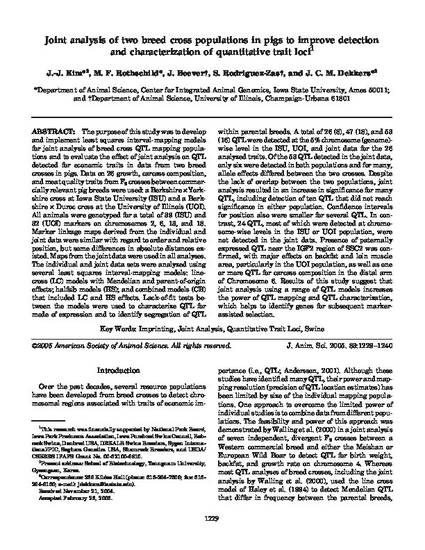
The purpose of this study was to develop and implement least squares interval-mapping models for joint analysis of breed cross QTL mapping populations and to evaluate the effect of joint analysis on QTL detected for economic traits in data from two breed crosses in pigs. Data on 26 growth, carcass composition, and meat quality traits from F2 crosses between commercially relevant pig breeds were used: a Berkshire × Yorkshire cross at Iowa State University (ISU) and a Berkshire × Duroc cross at the University of Illinois (UOI). All animals were genotyped for a total of 39 (ISU) and 32 (UOI) markers on chromosomes 2, 6, 13, and 18. Marker linkage maps derived from the individual and joint data were similar with regard to order and relative position, but some differences in absolute distances existed. Maps from the joint data were used in all analyses. The individual and joint data sets were analyzed using several least squares interval-mapping models: line-cross (LC) models with Mendelian and parent-of-origin effects; halfsib models (HS); and combined models (CB) that included LC and HS effects. Lack-of-fit tests between the models were used to characterize QTL for mode of expression and to identify segregation of QTL within parental breeds. A total of 26 (8), 47 (18), and 53 (16) QTL were detected at the 5% chromosome (genome)-wise level in the ISU, UOI, and joint data for the 26 analyzed traits. Of the 53 QTL detected in the joint data, only six were detected in both populations and for many, allele effects differed between the two crosses. Despite the lack of overlap between the two populations, joint analysis resulted in an increase in significance for many QTL, including detection of ten QTL that did not reach significance in either population. Confidence intervals for position also were smaller for several QTL. In contrast, 24 QTL, most of which were detected at chromosome-wise levels in the ISU or UOI population, were not detected in the joint data. Presence of paternally expressed QTL near the IGF2 region of SSC2 was confirmed, with major effects on backfat and loin muscle area, particularly in the UOI population, as well as one or more QTL for carcass composition in the distal arm of Chromosome 6. Results of this study suggest that joint analysis using a range of QTL models increases the power of QTL mapping and QTL characterization, which helps to identify genes for subsequent marker-assisted selection.
Available at: http://works.bepress.com/max-rothschild/71/

This is an article from Journal of Animal Science 83 (2005): 1229, doi:/2005.8361229x. Posted with permission.